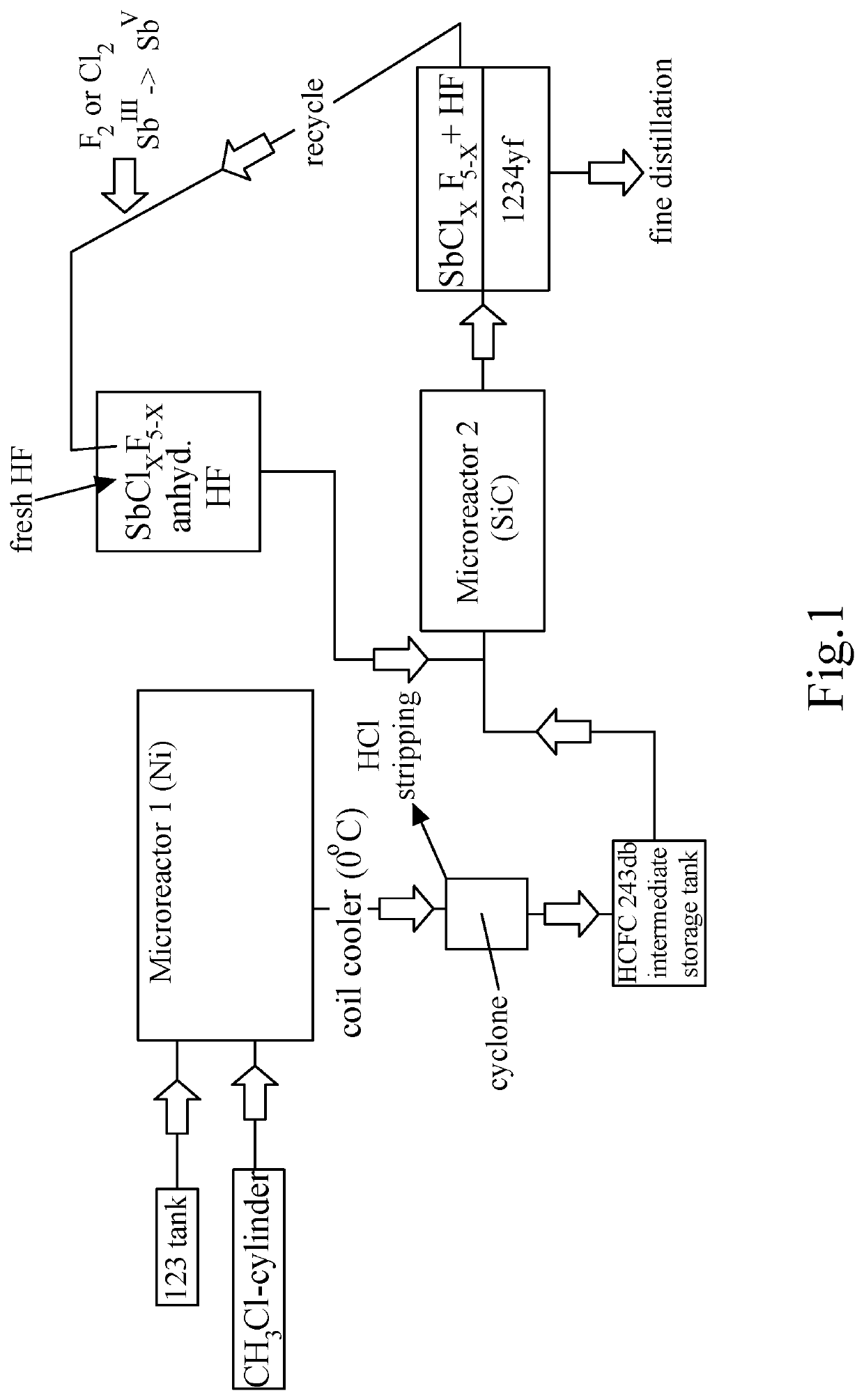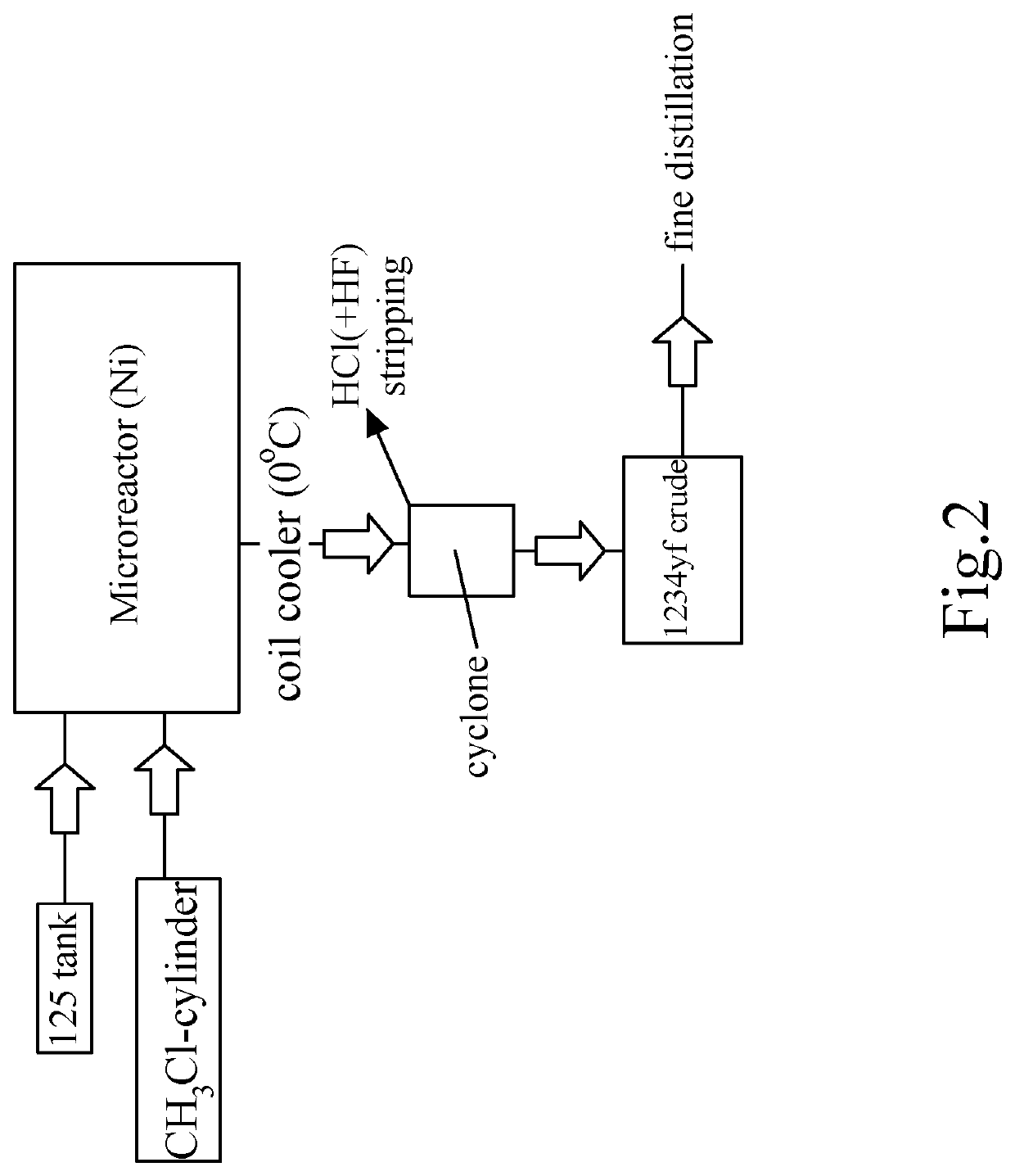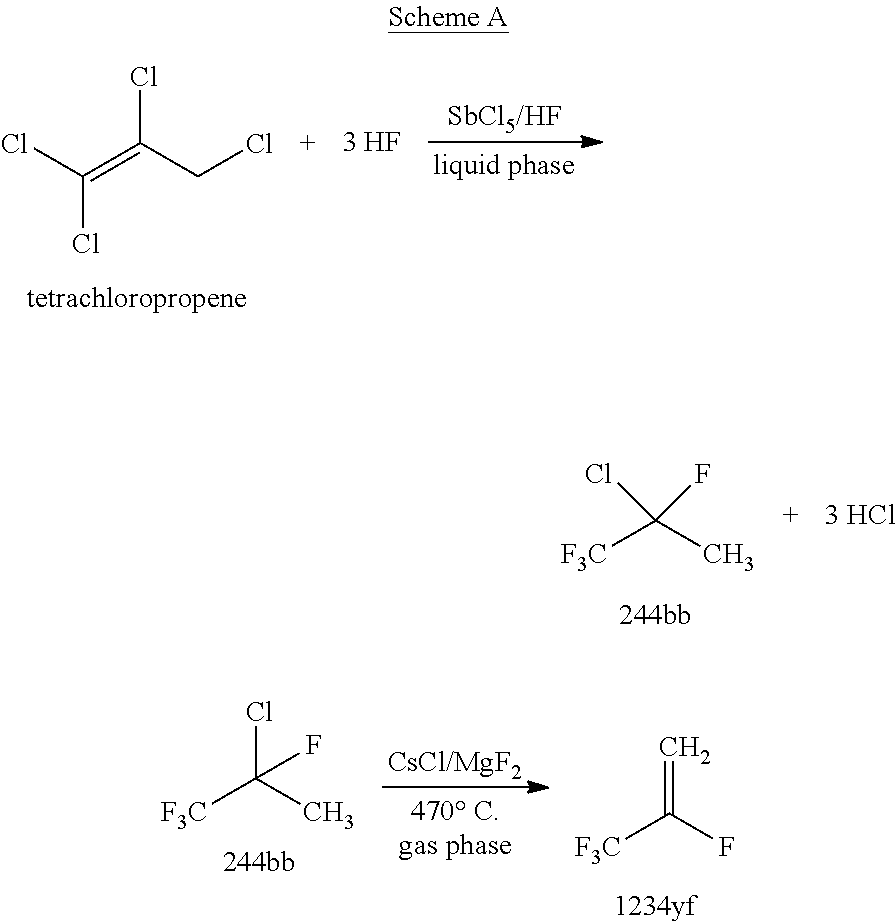Process for manufacture of 2-chloro-1,1,1-trifluoropropene
a technology of trifluoropropene and manufacturing process, which is applied in the preparation of halogenated hydrocarbons, physical/chemical process catalysts, hydrogen halide split-off, etc., can solve the problems of inability to meet the requirements of the fourth generation of refrigerant, inability to meet the requirements of the application, and low conversion rate, so as to achieve the effect of reducing and simplifying the number of separation steps, avoiding time and energy consumption, and reducing the number of separation
- Summary
- Abstract
- Description
- Claims
- Application Information
AI Technical Summary
Benefits of technology
Problems solved by technology
Method used
Image
Examples
example 1
s Synthesis of 1233xf Out of HCFC-123 at 800° C. in a Monel-Tube Reactor in Gas Phase
[0300]
[0301]A Monel tube (d=10 cm, volume around 6.5 1, electrically heated, N2-flow during heating up) was filled with 1 cm Ni-fillings from company Raschig (Germany). Once the reactor temperature reached 800° C., the 123 feed controlled with a Bronkhorst flow meter over a vaporizer (operated at 100° C.) was adjusted to 600 g / h (3.92 mol) and another Bronkhorst flow meter at 202 g / h (4.0 mol) chloromethane out of a gas cylinder into the Monel tube. The pressure was kept by a pressure valve at 2 bar abs. The gas stream leaving the reactor tube was fed over a 1 m cooled pipe (+20° C.) of 1 cm diameter into a water scrubber (operated at room temperature) to absorb HCl and to hydrolyze little amounts of phosgene like side products. A GC / GC-MS analysis of the gas steam leaving the scrubber indicated a quantitative conversion of 123 and selectivity to 1233xf of 96%. The gas steam after the scrubber was c...
example 2
s Synthesis of 1233xf Out of HCFC-123 at 800° C. in a Quartz Glass Tube Reactor in Gas Phase
[0302]A quartz tube (d=10 cm, length 30 cm) with electrical heating and a N2-flow during heating up) was filled with 1 cm quartz glass fillings. Once the reactor temperature reached 800° C., the 123 feed controlled with a Bronkhorst flow meter over a vaporizer (operated at 100° C.) was adjusted to 200 g / h (1.31 mol) and another Bronkhorst flow meter at 75.7 g (1.5 mol mol / h) Chloromethane out of a gas cylinder. The pressure was kept by a pressure valve at 1.2 bar abs. The gas stream leaving the reactor tube was fed over a 1 m cooled pipe (+25° C.) of 1 cm diameter into a water scrubber to absorb HCl and to hydrolyze potential phosgene like side products and some unstable intermediates and phosgenes. A GC / GC-MS analysis of the gas steam leaving the scrubber indicated a 81% conversion of 123 and selectivity to 1233xf of 89%. The gas stream after the scrubber was condensed into a stainless steel...
example 3
of 1233xf in Liquid Phase Under Phase Transfer Catalysis
[0303]In a 250 ml Roth autoclave with deep pipe and gas outlet, 50 ml 123 (73 g, 0.48 mol) were mixed with 28 g KOH pellets from Aldrich and 30 ml deionized water together with 2 g TBAB (tetrabutylammoniumbomide, 0.006 mol) also from Aldrich and the autoclave was closed. The autoclave was heated to 80° C. Afterwards, 73 g (0.48 mol) liquid 123 (using a piston pump) and 30.29 g (0.6 mol) Chloromethane (over a Bronkhorst flow meter out of a gas cylinder) were fed together over the deep pipe into the autoclave and the pressure was kept at 4 bar abs. with a pressure valve installed at the gas outlet of the autoclave. The gas stream leaving the reactor tube was fed over a 1 m cooled pipe (+25° C.) of 1 cm diameter into a water scrubber to absorb still some present HCl (most of the HCl remained in the autoclave). A GC / GC-MS analysis of the gas steam leaving the scrubber contained no 123 but mainly 1233xf. The gas stream after the scr...
PUM
| Property | Measurement | Unit |
|---|---|---|
| temperature | aaaaa | aaaaa |
| temperature | aaaaa | aaaaa |
| temperature | aaaaa | aaaaa |
Abstract
Description
Claims
Application Information
 Login to View More
Login to View More - R&D
- Intellectual Property
- Life Sciences
- Materials
- Tech Scout
- Unparalleled Data Quality
- Higher Quality Content
- 60% Fewer Hallucinations
Browse by: Latest US Patents, China's latest patents, Technical Efficacy Thesaurus, Application Domain, Technology Topic, Popular Technical Reports.
© 2025 PatSnap. All rights reserved.Legal|Privacy policy|Modern Slavery Act Transparency Statement|Sitemap|About US| Contact US: help@patsnap.com



